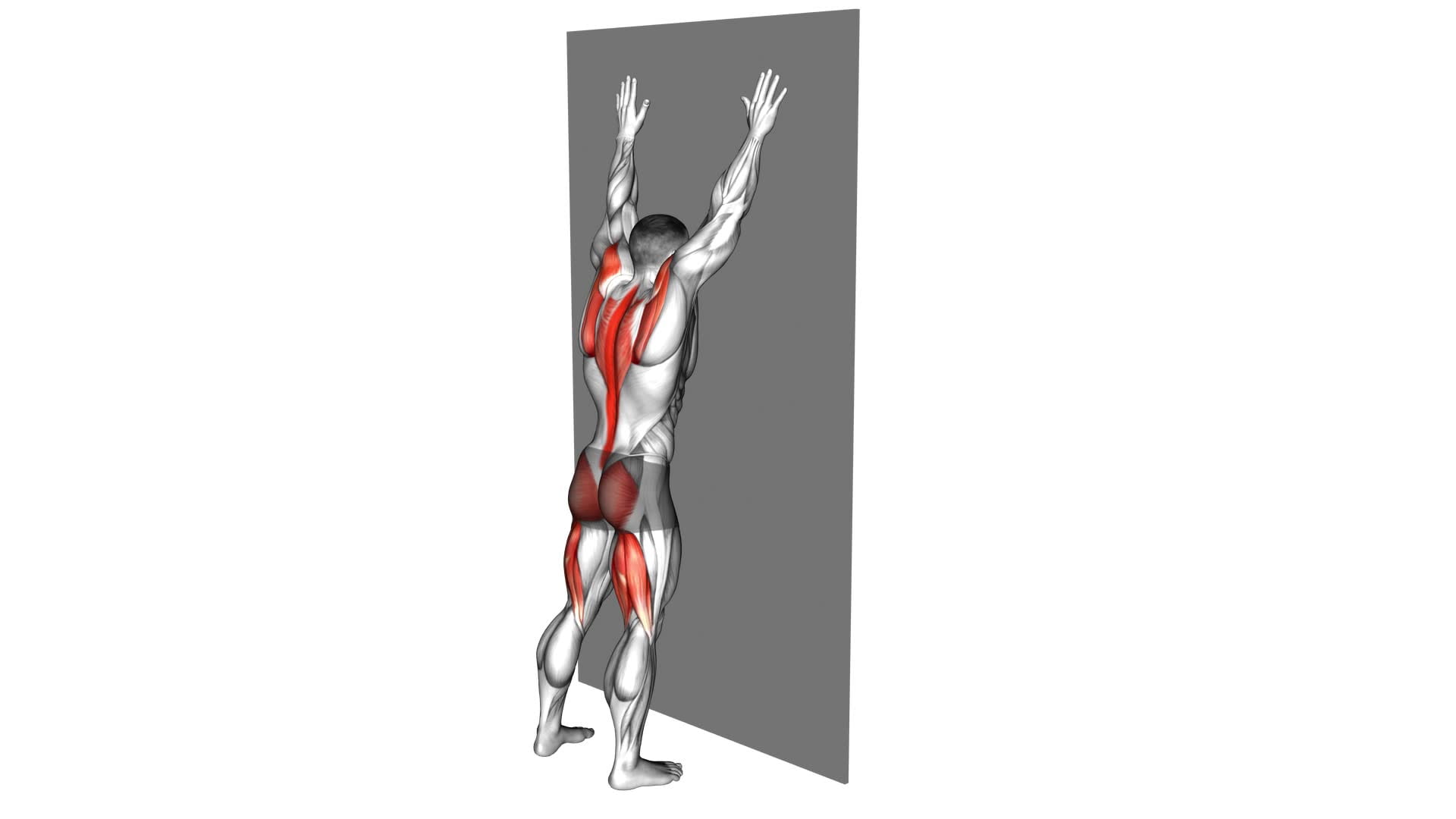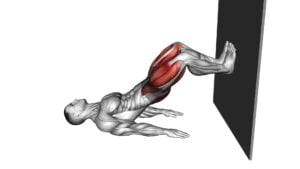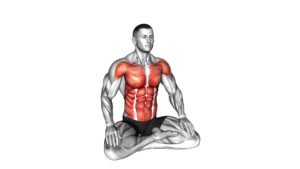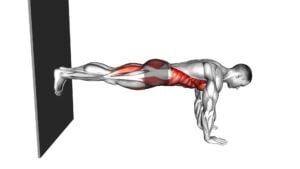Opposite Arm and Leg Raise Against Wall (Male) – Video Exercise Guide & Tips

Looking to amp up your workout routine? Get ready to challenge your core and improve your balance with the Opposite Arm and Leg Raise Against Wall exercise.
Watch This Exercise Video
In this video exercise guide, you'll learn the proper form and technique specifically designed for males. No need for fancy equipment – all you need is a wall.
Whether you're a beginner or advanced, we've got modifications and progressions for all fitness levels. Say goodbye to common mistakes and hello to a stronger you.
Let's get started!
Key Takeaways
- Opposite Arm and Leg Raise Against Wall improves balance, coordination, and overall stability.
- Proper form and technique for males include maintaining a neutral spine, engaging core muscles, and avoiding swinging or using momentum.
- Modifications and progressions for all fitness levels, including older adults and advanced athletes, can be made to tailor the exercise to individual fitness goals.
- Common mistakes to avoid include arching the back or rounding the shoulders, lifting the leg too high and straining the lower back, and lack of control and deliberate movements.
Benefits of Opposite Arm and Leg Raise Against Wall
To understand the benefits of performing the opposite arm and leg raise against a wall, you should know that this exercise helps improve balance and coordination. By incorporating proper breathing and muscle activation, you can enhance the effectiveness of this exercise.
Proper breathing is essential during any exercise, including the opposite arm and leg raise against a wall. As you raise your opposite arm and leg, exhale slowly through your mouth. This not only helps engage your core muscles, but also aids in stabilizing your body. By focusing on your breath, you can maintain control and stability throughout the movement.
Muscle activation is another key component of this exercise. As you raise your arm and leg, focus on activating the muscles in your core, glutes, and shoulder. Engaging these muscles not only improves your balance, but also strengthens your overall stability and coordination.
Proper Form and Technique for Males
Now let's focus on the proper form and technique for males when performing the opposite arm and leg raise against a wall. This exercise is great for strengthening the core, improving balance, and targeting the muscles in the shoulders, back, and glutes.
To ensure you're performing the exercise correctly, keep the following tips in mind:
- Maintain a neutral spine: Avoid arching or rounding your back during the movement. Keep your spine in a straight line from your head to your tailbone.
- Engage your core: Activate your abdominal muscles throughout the exercise to stabilize your body and protect your lower back.
- Keep your movements controlled: Avoid swinging your limbs or using momentum to lift your arm and leg. Focus on using the targeted muscles to perform the movement.
By following these proper form and technique guidelines, you can maximize the benefits of the opposite arm and leg raise against a wall while minimizing the risk of injury.
Now, let's move on to the next section to discuss the equipment needed for this exercise.
Equipment Needed for the Exercise
You will need a wall for this exercise. The opposite arm and leg raise against the wall is a bodyweight exercise that can be done at home or in a gym setting. No additional equipment is necessary to perform this exercise. However, there are exercise modifications and equipment options available if you want to change the intensity or add variety to your workout.
For exercise modifications, you can use a stability ball or a Bosu ball to increase the challenge and engage your core muscles even more. By placing your hands and feet on the ball instead of the wall, you'll have to work harder to maintain balance and stability throughout the movement.
If you prefer to use equipment, you can incorporate resistance bands or ankle weights to add resistance to the exercise. This will help to further strengthen your muscles and increase the difficulty level. Just make sure to choose the appropriate resistance level that matches your fitness level and goals.
Modifications and Progressions for All Fitness Levels
For all fitness levels, there are various modifications and progressions available to enhance the opposite arm and leg raise against the wall exercise. Whether you're an older adult looking for modifications or an advanced athlete seeking progressions, there are options to suit your needs. Here are three examples:
- Modifications for older adults:
- Start with a shorter hold time and gradually increase as you build strength and stability.
- Use a lower wall or a sturdy chair for support if needed.
- Perform the exercise in a seated position, focusing on maintaining proper form and alignment.
- Progressions for advanced athletes:
- Increase the hold time to challenge your core and improve endurance.
- Add ankle weights or resistance bands to increase resistance and intensify the exercise.
- Perform the exercise on an unstable surface, such as a balance board or Bosu ball, to engage more muscles and enhance stability.
By incorporating these modifications and progressions, you can tailor the opposite arm and leg raise against the wall exercise to your fitness level and goals.
Now, let's move on to the next section and discuss common mistakes to avoid, to ensure you get the most out of this exercise.
Common Mistakes to Avoid
To ensure proper form during the opposite arm and leg raise against the wall exercise, there are a few key tips to keep in mind.
Firstly, make sure to maintain a neutral spine throughout the movement, avoiding any excessive arching or rounding of the back.
Additionally, focus on engaging the core and glutes to stabilize the body and prevent any unnecessary movement.
Proper Form Tips
Regularly perform the Opposite Arm and Leg Raise Against Wall exercise to ensure proper form and avoid common mistakes.
To achieve optimal results and prevent injury, keep the following tips in mind:
- Maintain a neutral spine: Keep your back straight and avoid arching or rounding your lower back. This promotes proper alignment and reduces strain on the spine.
- Engage your core: Activate your abdominal muscles throughout the exercise. This helps stabilize your body and enhances overall strength and balance.
- Focus on muscle activation: Concentrate on engaging the targeted muscles, specifically the glutes, hamstrings, and upper back. This increases the effectiveness of the exercise and maximizes the benefits.
Benefits of Correct Technique
To ensure optimal results and prevent injury, it's important to understand the benefits of correct technique and the common mistakes to avoid when performing the Opposite Arm and Leg Raise Against Wall exercise.
Maintaining proper form during this exercise is crucial for maximizing its effectiveness. One of the key benefits of using the correct technique is that it targets multiple muscle groups simultaneously, including the core, glutes, and shoulders. By engaging these muscles in a coordinated manner, you can improve your overall strength and stability.
Additionally, proper form helps to minimize the risk of injury by ensuring that the load is distributed evenly throughout the body. It also allows for better alignment, which promotes better posture and reduces strain on the joints.
Tips for Incorporating Opposite Arm and Leg Raise Into Your Fitness Routine
To effectively incorporate the opposite arm and leg raise into your fitness routine, it's important to focus on proper form techniques. Ensure that you maintain a straight line from your head to your heels, engaging your core throughout the movement.
Additionally, beginners can start with variations such as performing the exercise on the floor before progressing to the wall.
These tips will help you maximize the benefits of this exercise and avoid potential mistakes.
Proper Form Techniques
To properly incorporate the opposite arm and leg raise into your fitness routine, it's important that you maintain proper form and technique. Here are some tips to help you do it correctly:
- Common Mistakes:
- Avoid arching your back or rounding your shoulders. Keep your spine neutral throughout the movement.
- Don't rush the exercise. Focus on controlled and deliberate movements to engage the targeted muscles.
- Avoid lifting your leg too high, as it can strain your lower back. Lift it to a comfortable height.
- Modifications:
- If you find it challenging to perform the exercise against a wall, you can start by doing it on the floor or a mat.
- To make it easier, you can perform the exercise without using any weights or resistance.
- Progressions:
- Once you have mastered the basic opposite arm and leg raise, you can add ankle weights or resistance bands to increase the intensity.
- You can also try performing the exercise on an unstable surface like a balance board to further challenge your stability and core muscles.
- Another progression is to perform the exercise without any support, balancing on one leg.
Remember to always listen to your body and adjust the exercise according to your fitness level.
Variations for Beginners
If you're a beginner looking to incorporate the opposite arm and leg raise into your fitness routine, here are some variations that can help you get started. These beginner modifications will allow you to gradually build strength and improve your balance.
First, you can start by performing the opposite arm and leg raise while lying on the floor instead of against the wall. This will provide more stability and support as you get accustomed to the movement.
Once you feel comfortable with the floor variation, you can progress to performing the exercise on an unstable surface, such as a balance board or a stability ball. This will challenge your core muscles even more and enhance your balance skills.
Remember to start with a lower number of repetitions and gradually increase as you become more proficient. Incorporating these progressions for all levels will help you develop the necessary strength and stability to perform the opposite arm and leg raise with proper form.
Frequently Asked Questions
How Many Repetitions Should I Do for Opposite Arm and Leg Raise Against the Wall?
You should aim to do a sufficient number of repetitions for the opposite arm and leg raise against the wall exercise.
This exercise targets shoulder stability and has numerous benefits. By raising your opposite arm and leg against the wall, you engage multiple muscles, improving your core strength and balance.
It's recommended to start with a manageable number of repetitions, gradually increasing as your strength and endurance improve. Remember to maintain proper form and listen to your body to avoid overexertion.
Can I Do This Exercise if I Have a Shoulder Injury?
If you have a shoulder injury, it's important to modify exercises to avoid further damage. Opposite Arm and Leg Raise Against Wall may not be suitable for you in this case.
However, there are alternative exercises that can help strengthen other areas without putting strain on your shoulder.
Consult with a healthcare professional or a certified trainer to find exercises that are safe and effective for your specific condition.
Is It Better to Do This Exercise Before or After My Cardio Workout?
Before or after your cardio workout, incorporating the Opposite Arm and Leg Raise Against Wall exercise can be beneficial. Strength training before cardio helps activate and warm up your muscles, preparing them for the cardiovascular activity. It also helps improve overall workout effectiveness by increasing muscular endurance and stability.
However, doing this exercise after cardio can also be effective in targeting specific muscle groups and promoting balance. Ultimately, the choice depends on your fitness goals and preferences.
Can I Use Ankle Weights to Increase the Intensity of the Exercise?
Yes, you can use ankle weights to increase the intensity of the exercise.
However, an alternative option is using resistance bands instead of ankle weights. This can provide a similar level of resistance while allowing for more flexibility and range of motion.
Additionally, if you're a beginner, you can start by performing the exercise without any weights or bands until you feel comfortable and confident.
Remember to always listen to your body and make modifications as needed.
Are There Any Specific Breathing Techniques I Should Follow While Performing Opposite Arm and Leg Raise Against the Wall?
When performing the opposite arm and leg raise against the wall, it's important to focus on proper form and breathing techniques.
Ensure that you maintain a neutral spine and engage your core throughout the exercise. As you raise your arm and leg, exhale and contract your abs. Inhale as you lower your limbs back to the starting position.
This controlled breathing pattern will help stabilize your body and maximize the benefits of the exercise.
Conclusion
Incorporating the opposite arm and leg raise against a wall into your fitness routine can provide numerous benefits for males. It helps to improve core strength, balance, and coordination while engaging multiple muscle groups.
By following proper form and technique, using the necessary equipment, and avoiding common mistakes, you can perform this exercise safely and effectively.
Whether you're a beginner or an advanced fitness enthusiast, modifications and progressions allow you to tailor the exercise to your fitness level.
Start incorporating this exercise into your routine for a stronger and more balanced body.

Author
Years ago, the spark of my life’s passion ignited in my mind the moment I stepped into the local gym for the first time. The inaugural bead of perspiration, the initial endeavor, the very first surge of endorphins, and a sense of pride that washed over me post-workout marked the beginning of my deep-seated interest in strength sports, fitness, and sports nutrition. This very curiosity blossomed rapidly into a profound fascination, propelling me to earn a Master’s degree in Physical Education from the Academy of Physical Education in Krakow, followed by a Sports Manager diploma from the Jagiellonian University. My journey of growth led me to gain more specialized qualifications, such as being a certified personal trainer with a focus on sports dietetics, a lifeguard, and an instructor for wellness and corrective gymnastics. Theoretical knowledge paired seamlessly with practical experience, reinforcing my belief that the transformation of individuals under my guidance was also a reflection of my personal growth. This belief holds true even today. Each day, I strive to push the boundaries and explore new realms. These realms gently elevate me to greater heights. The unique combination of passion for my field and the continuous quest for growth fuels my drive to break new ground.







